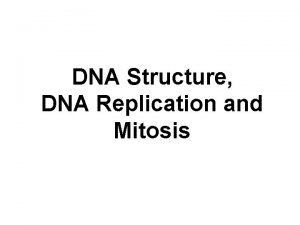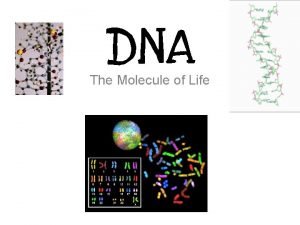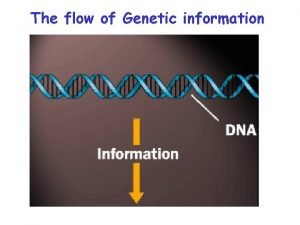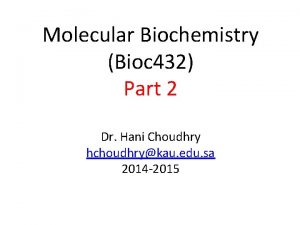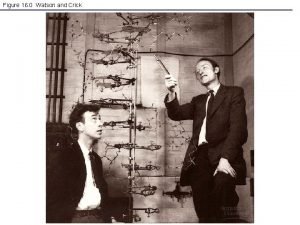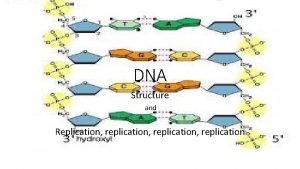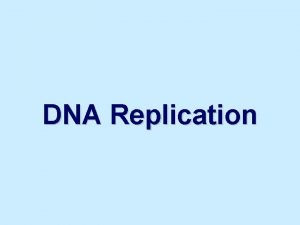DNA STRUCTURE AND REPLICATION DISCOVERY OF DNA has










- Slides: 10

DNA STRUCTURE AND REPLICATION

DISCOVERY OF DNA has been known about for a long time, but it’s structure was a mystery until the 1950’s, when a group of scientists working at Cambridge University in England came up with a model of it’s structure.

ROSALIND FRANKLIN Rosalind Franklin worked in the X-ray lab, and took pictures of DNA, which helped James Watson and Francis Crick discern the overall spiral structure of the DNA molecule.

JAMES WATSON AND FRANCIS CRICK Came up with what is now known as the double helix model of DNA (deoxyribonucleic acid). The macromolecule is composed of 2 strands that connect in the middle and on the sides. They form a 2 -sided spiral. The sides of the molecule are composed of phosphate and sugar (deoxyribose), and the “rungs” are the 4 nitrogen bases – adenine, thymine, cytosine and guanine.

DEOXYRIBONUCLEIC ACID A single monomer of the macromolecule is called a nucleotide. It has this general shape: The bases vary depending on if they are purines (adenine and guanine) or pyrimidines thymine and cytosine).

DEOXYRIBONUCLEIC ACID The nitrogen bases in a DNA molecule attach together with hydrogen bonds. These bonds hold the bases together in a certain order, so that adenine binds to thymine, and cytosine binds to guanine. This is known as the “base-pairing rule. ”

DEOXYRIBONUCLEIC ACID A strand of DNA on one side of the double helix is said to have a “complimentary strand” – one where the base sequence can be determined using the base -pairing rule. e. g. if a DNA strand has the sequence A G C T C G A, T C G A G C T then it’s complimentary strand will be

WHAT IS DNA REPLICATION? DNA replication is known as a semi-conservative replication, where new DNA strands are formed from pre-existing strands that are already found in the cell. A double stranded DNA molecule “unzips, ” freefloating nucleotides attach to the exposed strands that result, and these then build complementary strands on the exposed strands. animation

WHERE AND WHEN DOES DNA REPLICATION TAKE PLACE Replication occurs in the S (synthesis) phase in interphase of the cell cycle. This only occurs in the nucleus of eukaryotes S phase DNA replication takes place in the S phase. G 1 interphase Mitosis -prophase -metaphase -anaphase -telophase G 2

WHY IS DNA REPLICATION NECESSARY? DNA replication ensures that the DNA of a cell is copied exactly before cell division occurs. Daughter cells produced at the end of cell division will have an identical set of DNA to each other, and the cell that produced them. This ensures genetic continuity.
 Bioflix activity dna replication lagging strand synthesis
Bioflix activity dna replication lagging strand synthesis Dna polymerase function in dna replication
Dna polymerase function in dna replication Chapter 11 dna and genes
Chapter 11 dna and genes Haploid vs diploid
Haploid vs diploid Dna structure and replication packet answer key
Dna structure and replication packet answer key What is the purpose of dna replication
What is the purpose of dna replication Dna replication transcription and translation
Dna replication transcription and translation Amino acid decoder
Amino acid decoder 3-5 exonuclease vs 5-3 exonuclease
3-5 exonuclease vs 5-3 exonuclease Okazaki fragments
Okazaki fragments Polyribosomes
Polyribosomes





